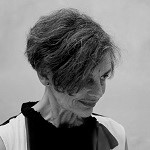In the beginning, Elisabeth Schimana worked with her voice. That was in the ‘80s, “no less than 30 years ago,” as she says. “And things sure do mount up.” In this case, 30 years of pioneering work at the nexus of art, technology and feminism. As Featured Artist at this year’s Ars Electronica Festival (September 6-10, 2018), Schimana will provide insights into trailblazing work done by her and nine other female media artists.
“You just sing, we’ll do the rest”
This is extraordinary, above all because Schimana herself long had the feeling that women were the exception to the rule in electronic music. Excited by the first live performances with computers and digital electronics in the ‘80s, she soon turned away from vocal work and instead began experimenting with electro-acoustics. Her male colleagues often had one and the same reaction: “The guys always said ‘You just sing, we’ll do the rest,’ Schimana recalls. “And I thought—this is definitely not what I want. I have to do this myself.”
No sooner said than done. Schimana began the study of electro-acoustics and experimental music—Elak for short—at the University of Music and Performing Arts Vienna. “Thus, many things in my life have begun out of necessity,” Schimana says today, matter-of-factly.
Of Tape Recorders and Ataris
Tasks that are now done almost exclusively on the computer entailed laborious work with tape recorders and analog technology in those days. “This time was right in the middle of the transition to digital,” the artist recalls. At first, you often had to wait for days and nights for the machines to finish their computations and turn out a couple of seconds of sound. “Then came the ’90, and the innovations came fast and furious.”
The new decade brought a lot of new developments for Schimana too. After completing her Elak studies, she went to work for Kunstradio. “My areas of emphasis were vocals and electronics over the course of many years there,” Schimana said. Digital live electronics were hot; performances with light & video projections were the rule. “These were dreadful visualizations of the music, visuals that seemed totally pointless to me,” the musician recalls. “In the 2000s, I totally refused to keep working with images and video. And I still do today.”
Women? Passed over in silence.
As much as Schimana’s style has changed over the years, she has remained steadfastly true to her substantive focal point—women in electronic music. Even during her undergraduate days, Schimana resented the total absence of women in the instructional materials. “I thought to myself: it’s simply impossible that there’s not one female artist.” She looked into the matter and discovered a different story: “Of course they were there. They simply didn’t tell us about them.”
Schimana began to learn more about women in electro-acoustic music past and present: Eliane Radigue, who experimented intensively with the ARP synthesizer in the ‘50s; Beatriz Ferreyra, an Argentine artist who’s been working in electronic music for almost 50 years now; and Electric Indigo, the Austrian Techno DJ, feminist and founder of a platform named female:pressure.
From Portraits to an Institute
Soon, Elisabeth Schimana began to take the results of her search for women in electronic music and integrate them into her own work. One of the pieces that emerged from this was “Portrait 01 Die Futuristin,” a 2003 composition in which female artists’ voices and stories are mixed and interwoven. “So this was the birth of the portrait idea,” Schimana says, alluding to the works that were the point of departure for her exhibition and performances at the Ars Electronica Festival: IMA fiction.
The series of portraits of female artists in electronic music came about in conjunction with the IMA–Institute for Media Archeology that Elisabeth Schimana founded in 2005. “My vision was to make this a matter of media archeology with the emphasis on acoustics,” Schimana says of the IMA’s inception. “But this was also to be about women, art and technology.”
Digging: Excavations of Productions by Women
The institute does digging—media-archeological excavating to bring to light electro-acoustic productions by women. The events and exhibitions curated by IMA also focus on women “because, in my head, I have a key: at least 50:50,” Schimana explains. There have to be presentations of at least as many women as men, “no ifs, and or buts.” And she adds: “If more curators had such a key in their head, then festival programs would look very different.”
They are indeed there, these women in digital art and electro-acoustics, and it’s high time to showcase them. Just like Featured Artist Elisabeth Schimana September 6-10, 2018 at the Ars Electronica Festival. “In the IMA fiction series, we’re making an effort to tell other stories.” Namely, narratives in which women play the lead role for a change. And that’s a good thing!

Elisabeth Schimana examines in her artistic work questions of space, communication, or the body in its presence or absence, especially the imparting of compositional concepts (scores), which gives rise to completely new approaches that experimentally explore how we hear and demand a heightened musical presence on the part of the performer. Her probing approach also led her to found the IMA Institute of Media Archeology, which has dedicated itself since 2005 to acoustic media at the analogue/digital interface and to the subject of women, art, and technology.
“Hidden Alliances,” an exhibition by Ars Electronica Festival Featured Artist Elisabeth Schimana, will run at the LENTOS Art Museum September 6-30, 2018. In addition to this series of portraits of women in electronic music, “IMA fiction” will also give live performances at selected times. Details will be posted to our website shortly.
To learn more about Ars Electronica, follow us on Facebook, Twitter, Instagram et al., subscribe to our newsletter, and check us out online at https://ars.electronica.art/news/en/.
